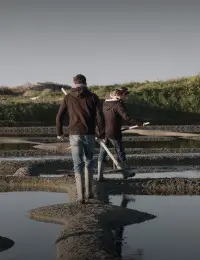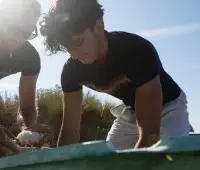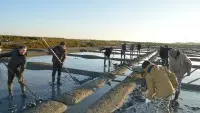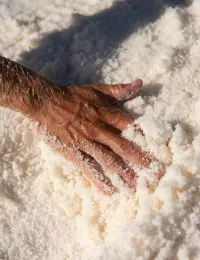

The salt workers
Heirs and guardians of a unique heritage
For centuries, the paludiers of Guérande, the land of salt, have passed on their ancestral know-how to harvest the treasure of Brittany's salt marshes. Being a salt worker means being a magician: extracting salt from a drop of water.
Salt workers, more than a job, a passion
Surrounded by lush flora and fauna, the salt workers do their work in the heart of nature. Passionate about the environment, these salt lovers are committed to preserving this exceptional site and working in symbiosis with it.
As a son and grandson of salt workers in Guérande, nature was a defining element of my upbringing. And it has become my way of life
Complete freedom is something I really value: being my own boss, having no employees...These precious advantages exist in very few professio
“I've always been immersed in the world of the salt marsh. When I was a child, it was part of my daily life."


A united and ethical collective
The profession of salt worker draws its essence from authentic values: love of the land and its preservation, while perpetuating traditions.
An intense world where man and nature are one.
Although guided by their freedom and a sometimes solitary daily routine, this ancestral know-how is a universe of solidarity built around sharing and passing down knowledge. A profession that finds its strength in the collective.


Unique training that gathers a thousand years of knowledge
Wishing to pass on the know-how and experience of salt workers to future generations, Le Guérandais Cooperative has set up a training center for salt workers that is unique in the Atlantic Arc, in partnership with the Chamber of Agriculture.
With the support of an internship supervisor, apprentices can familiarize themselves with the technical aspects of salt farming and discover the trade of salt worker. They also learn about the running and management of a farm.
The salt worker's trade: a passion for the seasons
While harvesting takes place in summer, preparing and maintaining the salt pans mobilizes salt workers all year round: alone or collectively, salt producers adapt their work to the rhythm of the seasons.

The little dictionary the salt worker
From barbotage to trémet, via ladure and lotie, immerse yourself in the world from salt and the salt workers of Guérande.

The tools the salt worker
From the lousse to the boutoué, via the boyette and the cesse, discover the tools of the Guérande salt workers.

All the news of Le Guérandais Cooperative
To find out more about the extraordinary heritage of the salt marshes, its events and the strength of Le Guérandais Cooperative, take a look at our dedicated articles!










